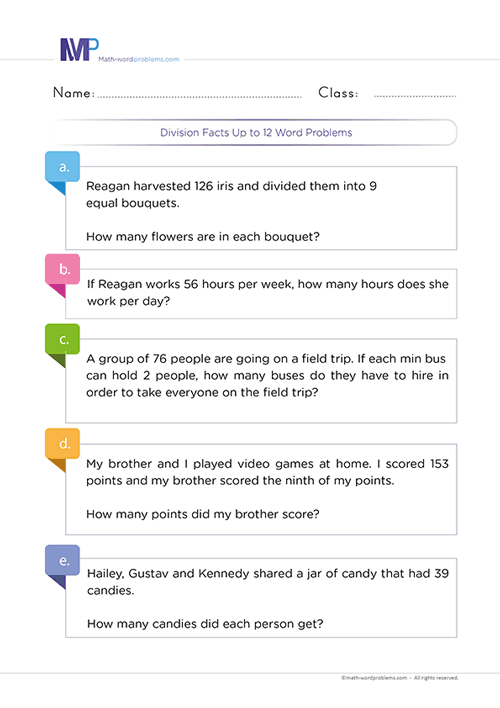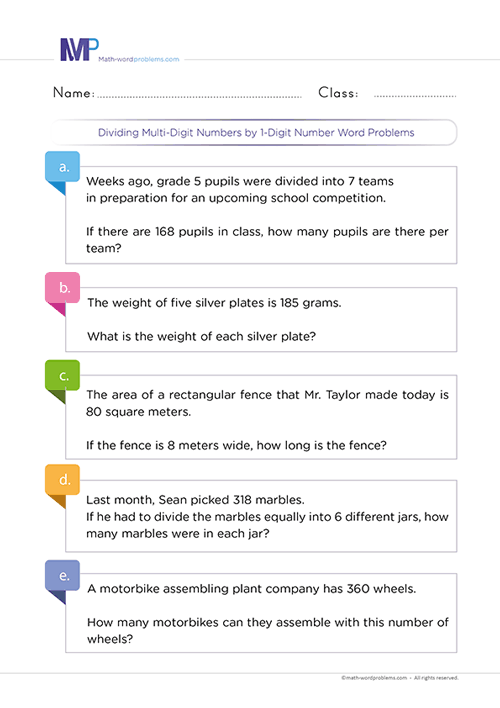 How to divide decimals by whole numbers word problems
How to divide decimals by whole numbers word problems
We have for 5th graders here the best guide on how to divide decimals by whole numbers word problems. After going through our step-by-step guide, they can construct practical and logical mental representations containing all the elements needed to divide decimals by whole numbers word problems efficiently.
They will also be able to:
- Accurately understand the text of the word problem,
- Identify the problem structure accurately,
- Interpret the problem structure in less than no time,
- Translate the problem structure into a math equation,
- And eventually provide an accurate solution to the word problem;
Steps on how to solve division of decimals by whole numbers word problems
The following steps on how to solve division of decimals by whole numbers word problems will enhance a deeper understanding of how to strategize, set up an equation and provide a solution to the division of decimals word problems adequately.
Since the most significant challenge for learners is to get an adequate understanding of the word problem statement, we have designed these steps so that they can easily learn how to translate the word problem into a qualitative mental representation.
In addition, we equally believe that the well-formulated examples added below will demonstrate how easy these steps work.
Step 1: IDENTIFY THE PROBLEM:
To identify the problem, you must read the word problem very carefully to know what the problem wants you to solve. Hence, always try to find the essential numbers and keywords in the word problem before solving the problem.
So, whenever you come across one of the following keywords in a word problem: - divide, half, evenly, every, per, parts, out of, quotient of, ratio of, how many in each, equal parts, cut up, average, as much, etc., it implies that you have to perform a Division Operation.
Note: One key Element for learners to understand is that they should not always rely on keywords alone. That is to say; the same keyword can have different meanings in different word problems.
For this reason, we reiterate on the importance of reading the question very carefully to understand the situation that the word problem is describing, then figure out exactly which operation to use
Step 2: STRATEGIZE OR GATHER RELEVANT INFORMATION:
How do you tackle this problem?
- First, from the keyword(s) in the word problem, you will know whether you need to perform a Division Operation or any other operation.
- Besides this, you must not rely only on keywords. Always try to read and understand the situation that the problem is describing.
- Then, after knowing which operation you will perform, build short expressions/sentences to represent the given word problem.
Step 3: SET UP AN EQUATION:
When setting up an equation, write down a numerical equation representing the information given in the word problem.
Step 4: PROVIDE A SOLUTION:
From step 3 above, you will divide the values using the long division method. Pad with zeros if necessary. Remember always to recall and include the unit of measurement to your final result, if any.
Step 5: CHECK YOUR WORK:
Finally, check if your answer makes sense. For instance, estimate the answer and see if it is close to what you expected. However, if the answer is not what you expected, go back to step one and start all over again.
Examples on how to divide decimals by whole numbers word problems.
Example one
Step 1: First, the important numbers here are 1,484,990 and 15. You also see that the most important keyword(s) found in the word problem is "each."
Step 2: Next, how will you solve the problem? What exactly is the question trying to tell us? From the situation the problem is describing and its keyword, you have to perform a division operation.
Also, this question mentions two units of measurement, and you will provide your answer in only one. So what does that tell you? You have to visit your metric unit of the measurement conversion table.
Now, build short sentences to represent the given word problem.
- Total weight of the bags of cement = 1,484,990g.
- Number of bags of cement = 15.
- Therefore, the weight of each bag of cement = The total weight of the bags of cement ÷ the number of bags of cement.
Step 3:Now, write down a numerical expression to represent the bolded sentence in step 2 above to solve this word problem:
→ 1,484,990g ÷ 15 = ?
Step 4:From step 3 above, divide the values using the long division method. Pad with zeros if necessary. Remember to add the unit of measurement to the final result if any.
But before you go into performing the proper division operation, notice that the equation is telling you to divide whole numbers only. But your area of concern is to divide decimals by whole numbers (take note this is where your reading and understanding skills come into play)
So, since you need to calculate the weight of each bag in kilograms, converting from grams to kilograms first before dividing will take you in the right direction.
If 1,000g = 1kg,
Then, 1,484,990g = (1,484,990g ÷ 1000) kg = 1,484.99kg
You see that the equation 1,484,990g ÷ 15 will be equal to 1,484.99kg ÷ 15 =?
Now you can go ahead and divide because you are now working with dividing a decimal by a whole number.
98.99kg to the nearest whole number is 99kg
So, each bag of cement weighs 99kg (to the nearest whole number)
Step 5: Finally, check if your answer makes sense. For example, estimate the answer and see if it is close to what you expected. However, if the answer is not what you expected, go back to step one and start all over again.
Example two
Step 1: The important numbers here are $781,255.25 and 5. Also, the keyword(s) found in the word problem are "equally" and "each."
Step 2: Next, how will you solve the problem? You see that the situation the problem is describing and the keyword(s) found in the word problem call for you to perform a division operation.
Now with this in mind, form short sentences to represent the given word problem.
- Total amount of money the foundation raised = $781,255.25.
- Number of orphanages they want to share the money to = 5.
- Therefore, the amount of money each orphanage will receive = the amount of money the foundation raised ÷ the number of orphanages they want to share the money to.
Step 3: Now, write down a numerical equation to solve this word problem:
$781,255.25 ÷ 5 = ?
Step 4: From step 3 above, divide the values using the long division method. Pad with zeros if necessary. Remember, do not forget the unit of measurement, if any.
So, each orphanage will receive $156,251.05.
Step 5: Finally, check if your answer makes sense. For example, estimate the answer and see if it is close to what you expected. However, if the answer is not what you expected, go back to step one and start all over again.






